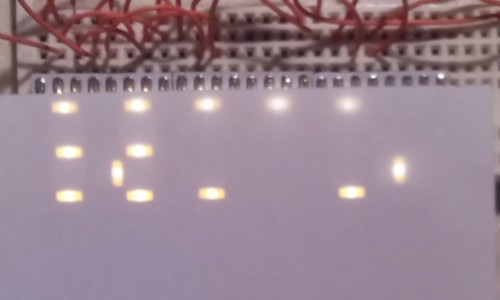Since the beginning of the #DYPLED project, I've been wondering how to provide a better aspect with the least means. The display is nice as it is but it can still get better. Today I could finally test my hypothesis :-)
This is the display modules, shot with my crappy smartphone camera :

Adding a simple, dumb sheet of white paper in front makes it look like this :

This is obviously visually more pleasing, I think.
Now, there are many problems to solve:
- Paper is not durable. What plastic foil/film/sheet is best suited ?
- The dots don't all appear nicely because the sheet could not stick to the surface of all the LEDs. Conclusion : the surface diffusor must be adhesive...
- Does the PCB's soldermask color matter anymore ? Could black further enhance the contrast ?
I'll test more ideas, meanwhile, I'd love to read yours in the comments :-)
20160909:
I tried various diffusion sheets from broken LCD screens. The results are not as expected. LCD diffusors do their best to not waste photons and spread light as much as possible.
Paper OTOH absorbs quite a lot of light, which increases the contrast. I'll have to find a very thin adhesive label...
 Yann Guidon / YGDES
Yann Guidon / YGDES
Discussions
Become a Hackaday.io Member
Create an account to leave a comment. Already have an account? Log In.
Nice! I would try the backlight diffusion layer from old/broken PC-Monitors. Or clear acrylic sheets sanded with fine sandpaper
Are you sure? yes | no
New LCD have fewer diffusion layers and don't use translucent diffusion sheets... I know, I have a large pile of broken LCD screens from a repair shop, that I use for their backlight :-)
Anyway there are so many things to try !
Are you sure? yes | no
If you're looking to improve contrast without diffusing (so you can see the inner workings, but also see the lit segments better), there are some other choices. Clear color filters work great for contrast enhancement on colored LEDs but with white LEDs, colored filters don't work as well. On the other hand, a 50% neutral density filter will increase contrast by 2x: the light from the LED will only pass once through the filter, while ambient light will have to pass through twice, once in and once out. "window tint film" used to darken car windows is cheap, self-adhesive, and readily available (around here, at least). Darker filters increase contrast even more; the enhancement is T/(T^2) or 1/T for a filter of transmission T. Of course, darker filters also dim the LED output more, so you have to strike a balance.
Are you sure? yes | no
Thanks for the feedback :-)
It appears that luminosity is not a problem because the LEDs are strong at 3.3V. Some attenuation is possible. Ideally, not too much, to save energy.
Still, it's not comparable to the TIL311's power consumption :-D
Are you sure? yes | no
https://hackaday.io/project/10280-4-digit-charlieplexed-segment-display/log/41967-new-board/discussion-60824
Are you sure? yes | no
I saw this nice stack already but I was more thinking along the lines of sticky tape or LCD panel diffuser or...
Something VERY thin and more durable than cellulose/paper :-)
Are you sure? yes | no
Mylar® A (Frosted, Milky White Translucent) (aka Electrical Grade Mylar), drafting mylar, parchment paper (not to be confused with wax paper)
http://photo.stackexchange.com/questions/8371/what-are-the-best-and-worst-diffuser-materials-for-diy-softbox-light-tent
https://www.alibaba.com/showroom/light-diffuser-film.html
Are you sure? yes | no
Thanks ! I'll try to find adhesive versions :-)
Are you sure? yes | no